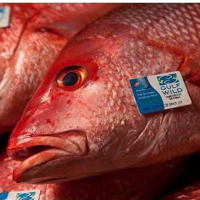74% of Surveyed L.A. County Seafood Stores and Restaurants Have Mislabeled Fish

Crawfish is not lobster. Pacific rockfish is not red snapper. Flounder is not halibut. And, frankly, “white tuna” only exists in sushi bars and Wikipedia.
But that doesn’t stop Los Angeles County grocery stores and restaurants from mislabeling them that way, often to their financial benefit and occasionally to their customers’ medical detriment. Pregnant women are particularly at risk.
The L.A. County Department of Health, at the direction of the county Board of Supervisors, formed the joint Seafood Task Force with the U.S. Food and Drug Administration and found mislabeled fish at 74% of the 103 grocery stores and restaurants they surveyed. Label and menu violations included species substitution, incorrect point of origin information and undeclared allergens.
The task force visited 66 restaurants, including branches of Vons, Ralphs, Albertsons and Trader Joe’s, and 37 restaurants, including P.F. Chang, Wokcano, Siete Mares and Echi Sushi.
Eight of the violators (10%) advertised “white tuna,” but served escolar. That was problematic in a few ways. For one, as the task force report points out, “there is no species or standard of identity with the designation of ‘white tuna.’ ” For another, in the words of the Medellitin food blog dedicated to modern cuisine, it is “The World’s Most Dangerous Fish.” Although rich in flavor, it gets its trademark buttery consistency from the wax esters (oils) it accumulates in its tissue, passing them along to unsuspecting eaters. The result for those with gastrointestinal sensitivity is a laxative-like effect that manifests itself in “cramping, nausea, diarrhea, the itis and abdominal cramps.”
Red snapper is a favorite of the bait-and-switch. Nineteen of the violators (25%) sold tilapia, rockfish, pollock, tai seabream or something just like them that was either misbranded or advertised incorrectly. Imitation crab or crummier crab—Norwegian King Crab instead of Alaskan King Crab—was found six times (8%), and misleading information about salmon being sold or served was observed in 14 facilities (18%). Halibut was really striped bass, fluke and turbot in eight places (10.5%)
This kind of misinformation is nothing new, is well-documented over the years and relatively easy to detect if you’re looking for it. Two high school kids did DNA-bar code tests on New York City sushi and took the data to a friend in graduate school who found 14 of 57 samples were mislabeled as higher-priced fish.
The nonprofit group Oceana sampled the wares at 74 grocery stores and restaurants in Los Angeles earlier in the year and found that 55% of the 119 fish it sampled were misidentified. All of the red snapper samples were mislabeled. A 2011 investigation by the Boston Globe found 48% of fish in markets and restaurants were identified with the wrong species name and a 2006 study by Consumer Reports discovered that 56% of salmon labeled “wild” was actually farmed.
A 2004 University of North Carolina study revealed that 77% of the fish sold in United States markets as pricey red snapper is really something else. But that study also pointed out one of the problems besetting studies like these: convoluted rules that govern the naming of fish.
Pacific Red Snapper is the approved name for Pacific Rockfish in California, Washington and Oregon. But the name Red Snapper only applies when the fish is sold in the same state it was caught. An Oregon Pacific Rockfish can’t be snapper in California or Washington, unless it’s mislabeled.
–Ken Broder
To Learn More:
Is Your Lobster for Real? L.A. Task Force Discovers 74 Percent of Seafood Surveyed Is Mislabeled (by Christina Villacorte, San Gabriel Valley Tribune)
Mislabeled Seafood Sold in Restaurants and Grocery Stores Overview (Los Angeles County Public Health Department) (pdf)
Seafood in L.A. Frequently Mislabeled, Group Says (by Susan Carpenter, Los Angeles Times)
Oceana Targets Fishy Labeling Practices (by Peter Fimrite, San Francisco Chronicle)
- Top Stories
- Controversies
- Where is the Money Going?
- California and the Nation
- Appointments and Resignations
- Unusual News
- Latest News
- California Forbids U.S. Immigration Agents from Pretending to be Police
- California Lawmakers Urged to Strip “Self-Dealing” Tax Board of Its Duties
- Big Oil’s Grip on California
- Santa Cruz Police See Homeland Security Betrayal in Use of Gang Roundup as Cover for Immigration Raid
- Oil Companies Face Deadline to Stop Polluting California Groundwater





